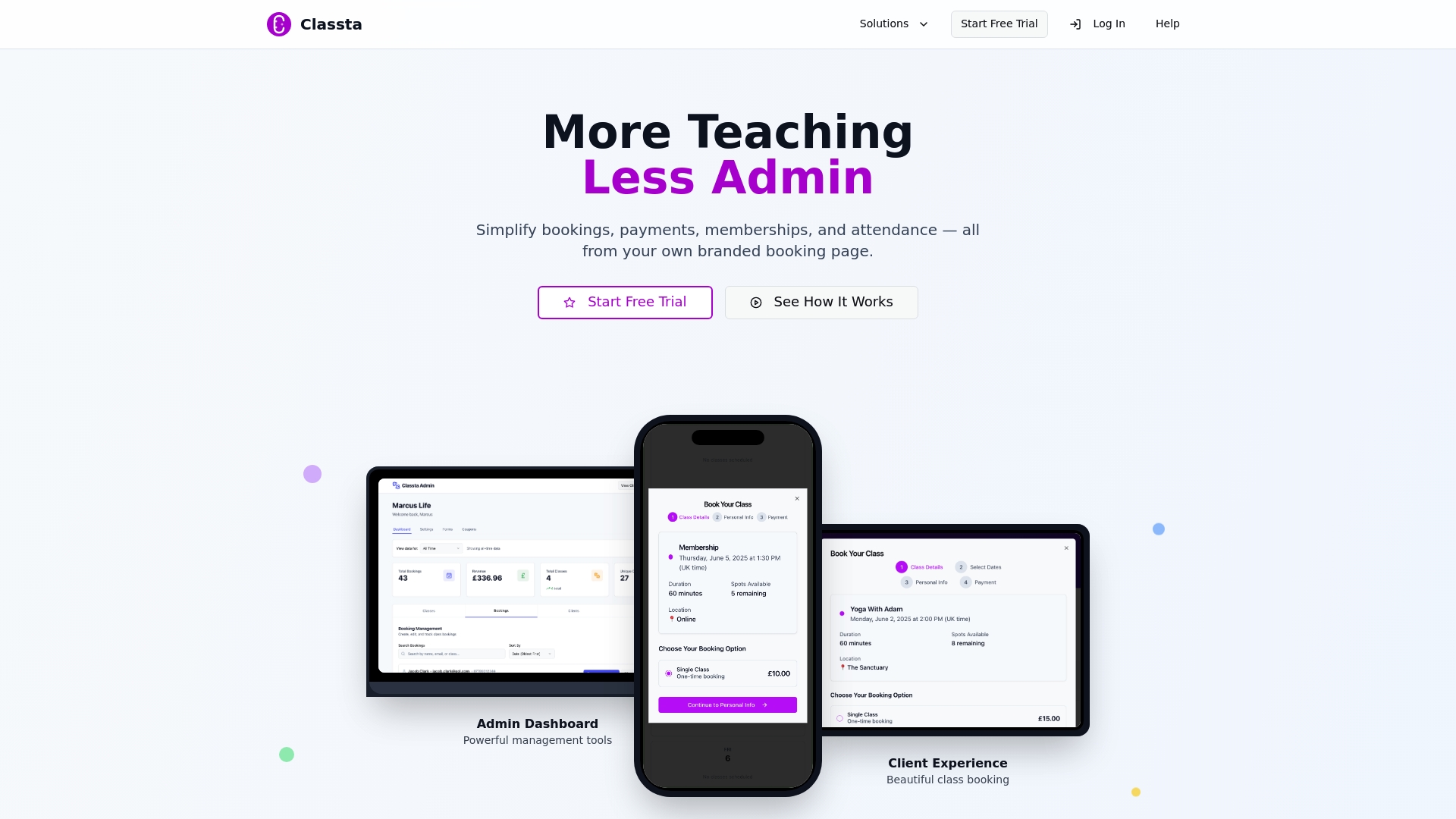Virtual class management is changing how instructors teach, students learn, and communities connect online. But here is the twist. While most would guess it is all about fancy tech tools or flashy video calls, the real magic is in the detail. Modern platforms now help instructors expand their reach far beyond borders, doubling or even tripling their client base through structured, engaging online experiences. This quiet revolution means the most successful instructors are those who have mastered the art of managing digital classrooms, not just setting them up.
Table of Contents
- What Is Virtual Class Management And Why It Matters?
- Key Concepts In Virtual Class Management Framework
- The Role Of Technology In Managing Virtual Classes
- Engagement Strategies For Virtual Fitness Classes
- Evaluating Success In Virtual Class Environments
Quick Summary
| Takeaway | Explanation |
|---|---|
| Effective virtual class management enhances student engagement. | Structured learning environments and interactive features promote participation and deeper learning. |
| Technology simplifies administrative tasks for instructors. | Automated workflows allow educators to focus on teaching rather than logistics, improving overall efficiency. |
| Data analytics inform instructional effectiveness. | Tracking learner progress and engagement helps instructors refine their teaching strategies and enhance outcomes. |
| Interactive communication strengthens class dynamics. | Effective use of real-time feedback and discussions fosters a sense of community and motivates participants. |
| Continuous improvement is vital for success. | Iterative assessment and feedback mechanisms help maintain relevance and adaptability in virtual learning environments. |
What is Virtual Class Management and Why It Matters?
Virtual class management represents a comprehensive approach to organizing, delivering, and monitoring online educational experiences across various digital platforms. At its core, this systematic methodology enables instructors to create engaging, structured learning environments that transcend physical classroom limitations.
Understanding the Fundamental Concept
Virtual class management integrates multiple technological tools and strategic processes to facilitate seamless online instruction. According to EdTech Perspectives, these systems are designed to address critical challenges in digital learning environments, ensuring smooth communication, student participation, and effective knowledge transfer.
Key components of virtual class management typically include:
- Digital course organisation and content delivery
- Real-time student interaction and engagement mechanisms
- Performance tracking and assessment tools
- Automated administrative workflows
The Strategic Importance for Modern Instructors
For fitness professionals, yoga instructors, and specialised class providers, virtual class management has become more than a convenience—it is now an essential operational strategy. Digital platforms enable instructors to expand their reach beyond geographical constraints, offering flexible learning experiences that accommodate diverse student schedules and preferences.
The transformation goes beyond simple online broadcasting. Effective virtual class management creates structured, interactive learning ecosystems where participants can connect, learn, and progress regardless of physical location. This approach allows instructors to maintain high-quality educational standards while dramatically increasing their potential client base and revenue streams.
Technology as an Enabler of Educational Excellence
Modern virtual class management solutions leverage advanced technologies to create immersive, responsive learning experiences. By integrating features like automated scheduling, secure payment processing, attendance tracking, and personalised communication, these platforms empower instructors to focus on delivering exceptional educational content rather than getting bogged down in administrative complexities.
The future of professional instruction is digital, interconnected, and highly adaptive—and virtual class management sits at the heart of this evolutionary process.
Key Concepts in Virtual Class Management Framework
Virtual class management involves sophisticated frameworks that transform digital learning experiences through strategic technological integration and pedagogical design. Understanding these foundational concepts allows instructors to develop robust, engaging online learning environments.
Core Architectural Components
The framework of virtual class management comprises interconnected systems that support comprehensive educational delivery. According to Digital Learning Research Network, these architectural components are essential for creating scalable and interactive online learning platforms.
Key architectural elements include:
![]()
- Infrastructure technology
- Communication protocols
- Content management systems
- User experience design
- Security and access management
Engagement and Interaction Mechanisms
Interaction design represents a critical concept in virtual class management. Modern platforms prioritize creating dynamic spaces where learners can actively participate rather than passively consume information. This approach transforms traditional one-way communication into multilayered, responsive learning experiences.
Interaction mechanisms typically encompass:
- Real-time video collaboration
- Discussion forums
Data-Driven Performance Monitoring
Instructors require sophisticated tracking and analytics tools to understand learner progression and engagement. Performance monitoring goes beyond simple attendance tracking, providing nuanced insights into individual and group learning dynamics.
Comprehensive performance tracking involves:
- Granular engagement metrics
- Learner progression analytics
- Personalised feedback mechanisms
- Predictive learning assessments
By understanding these intricate frameworks, instructors can design more effective, responsive, and personalised virtual learning experiences that meet diverse educational needs.
The following table summarises the core architectural components that form the foundation of modern virtual class management frameworks, providing a concise overview of each element and its primary function.
| Component | Function |
|---|---|
| Infrastructure technology | Supports platform scalability and reliable connectivity |
| Communication protocols | Enable real-time information exchange |
| Content management systems | Organise and deliver structured educational materials |
| User experience design | Enhances usability and learner engagement |
| Security and access management | Safeguards data and controls user permissions |
The Role of Technology in Managing Virtual Classes
Technology has become the fundamental infrastructure transforming how instructors deliver, monitor, and engage with online learning experiences. By seamlessly integrating sophisticated digital tools, professionals can create dynamic, interactive environments that transcend traditional educational boundaries.
Digital Infrastructure and Communication Platforms
Technological ecosystems serve as the backbone of virtual class management, enabling real-time interactions and comprehensive administrative capabilities. According to Research Gate, these platforms facilitate sophisticated communication mechanisms that support complex educational workflows.
Key technological capabilities include:
- Synchronous video conferencing
- Cloud-based content sharing
- Interactive collaborative workspaces
- Secure authentication protocols
- Multi-device compatibility
Automated Management and Workflow Optimization
Intelligent automation represents a pivotal technological advancement in virtual class management. These systems streamline administrative tasks, allowing instructors to concentrate on delivering high-quality educational content rather than managing logistical complexities.
Advanced technological features encompass:
- Automatic attendance tracking
- Integrated payment processing
- Scheduling and booking management
- Performance analytics generation
- Client communication automation
Enhanced Learning Experience Design
Technology enables unprecedented personalisation and adaptive learning experiences. By leveraging data analytics and intelligent algorithms, instructors can create tailored educational journeys that respond dynamically to individual student needs and learning patterns.
These technological innovations transform virtual classes from simple information transmission platforms into sophisticated, interactive learning ecosystems that prioritise engagement, accessibility, and measurable educational outcomes.
Engagement Strategies for Virtual Fitness Classes
Engagement represents the cornerstone of successful virtual fitness instruction, transforming passive online experiences into dynamic, interactive learning journeys. By implementing strategic approaches, instructors can create compelling digital environments that motivate, inspire, and connect participants across geographical boundaries.
Interactive Communication Techniques
Digital interaction goes far beyond simple video broadcasting. According to Journal of Interactive Learning Research, effective virtual fitness engagement requires multidimensional communication strategies that foster genuine participant connection and motivation.
Key interactive communication approaches include:
- Real-time participant feedback mechanisms
- Personalised instructor acknowledgement
- Group challenge and motivation systems
- Interactive Q&A sessions
- Virtual community building features
Technological Engagement Amplification
Technological tools play a crucial role in creating immersive fitness experiences. Modern platforms enable instructors to design interactive sessions that replicate the energy and motivation of in-person classes through innovative digital approaches.
Advanced engagement technologies encompass:
- Motion tracking and form correction systems
- Performance metric visualisation
- Gamification elements
- Leaderboard and achievement tracking
- Social sharing capabilities
Psychological Motivation Design
Successful virtual fitness engagement transcends technological features, requiring a deep understanding of participant psychology. By crafting experiences that address intrinsic motivation, instructors can create powerful digital fitness environments that inspire consistent participation and meaningful progress.
Psychological engagement strategies focus on creating a sense of community, personal achievement, and continuous improvement, transforming virtual fitness classes from isolated digital interactions into transformative personal development experiences.

Evaluating Success in Virtual Class Environments
Evaluating success in virtual class environments requires a sophisticated, multidimensional approach that transcends traditional assessment methodologies. Instructors must develop comprehensive strategies that capture the nuanced dynamics of digital learning experiences, measuring not just quantitative outcomes but qualitative engagement and participant transformation.
Performance Metrics and Data Analysis
Performance tracking provides critical insights into the effectiveness of virtual learning platforms. According to National Academies Press, successful evaluation encompasses a holistic examination of learner participation, engagement levels, and specific outcome achievements.
Key performance metrics include:
- Attendance and participation rates
- Skill progression tracking
- Completion of learning objectives
- Participant retention statistics
- Comparative performance benchmarks
Qualitative Assessment Techniques
Contextual evaluation recognises that numerical data alone cannot capture the complete learning experience. Modern virtual class management approaches integrate subjective assessment methods that provide deeper understanding of participant experiences and learning journeys.
Qualitative assessment strategies involve:
- Participant feedback surveys
- Individual progress narrative reviews
- Peer interaction quality analysis
- Self-reflection documentation
- Instructor observation reports
Continuous Improvement Framework
Successful virtual class environments are characterised by their adaptive nature. By implementing robust feedback loops and iterative assessment processes, instructors can continuously refine their teaching strategies, technological approaches, and participant engagement techniques.
This dynamic approach transforms evaluation from a static measurement tool into a proactive mechanism for ongoing educational enhancement, ensuring that virtual learning experiences remain responsive, relevant, and transformative.
This table compares performance metrics and qualitative assessment techniques used to evaluate success in virtual class environments, highlighting how each approach contributes to a well-rounded understanding of educational effectiveness.
| Evaluation Method | Examples | Purpose |
|---|---|---|
| Performance Metrics | Attendance rates, skill progression, retention rates | Quantifies learner participation and outcomes |
| Qualitative Assessment | Feedback surveys, progress narrative reviews, peer analysis | Provides insight into personal experiences |
Unlock Effortless Virtual Class Management with Classta
Struggling to organise your virtual classes, streamline communication, and keep track of every participant’s progress? The article highlighted the challenges of digital course organisation, real-time engagement, and administrative overload that many instructors face. Imagine replacing complicated manual workflows with a seamless, automated system designed around the very essentials of effective virtual class management.

Join the thousands of instructors already transforming their businesses at Classta.co. With easy branded booking pages, automated reminders, secure payments, AI-powered content tools, and real-time analytics, Classta empowers you to focus on teaching rather than administration.
Experience the difference today. Visit Classta to discover how our all-in-one platform brings clarity, efficiency, and growth to your virtual classes. Do not wait—competitors who adopt integrated class management will stand out and capture more clients. Take control and upgrade your class management now.
Frequently Asked Questions
What is virtual class management?
Virtual class management is a systematic approach to organising, delivering, and monitoring online educational experiences, utilising various digital platforms and tools to facilitate smooth communication, student participation, and effective knowledge transfer.
Why is virtual class management important for instructors?
Virtual class management is crucial for instructors as it expands their reach beyond geographical boundaries, facilitates structured and engaging learning environments, and enhances educational quality while increasing potential client bases and revenue streams.
What technology is typically involved in virtual class management?
Key technologies in virtual class management include digital course organisation systems, real-time communication tools, performance tracking and assessment features, and automated administrative workflows, all aimed at creating immersive online learning experiences.
How do instructors evaluate success in virtual class environments?
Instructors can evaluate success through performance metrics such as attendance rates, skill progression, and participant retention, as well as qualitative assessment techniques including participant feedback surveys and individual progress reviews, allowing for a comprehensive understanding of the learning experience.
